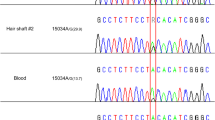Abstract
The analysis of mitochondrial DNA (mtDNA) from shed hairs has gained high importance in forensic casework since telogen hairs are one of the most common types of evidence left at the crime scene. In this systematic study of hair shafts from 20 individuals, the correlation of mtDNA recovery with hair morphology (length, diameter, volume, colour), with sex, and with body localisation (head, armpit, pubis) was investigated. The highest average success rate of hypervariable region 1 (HV 1) sequencing was found in head hair shafts (75%) followed by pubic (66%) and axillary hair shafts (52%). No statistically significant correlation between morphological parameters or sex and the success rate of sequencing was found. MtDNA sequences of buccal cells, head, pubic and axillary hair shafts did not show intraindividual differences. Heteroplasmic base positions were observed neither in the hair shafts nor in control samples of buccal cells.
Similar content being viewed by others
Author information
Authors and Affiliations
Additional information
Received: 18 January 1999 / Accepted: 15 February 1999
Rights and permissions
About this article
Cite this article
Pfeiffer, H., Hühne, J., Ortmann, C. et al. Mitochondrial DNA typing from human axillary, pubic and head hair shafts – success rates and sequence comparisons. Int J Leg Med 112, 287–290 (1999). https://doi.org/10.1007/s004140050251
Issue Date:
DOI: https://doi.org/10.1007/s004140050251




